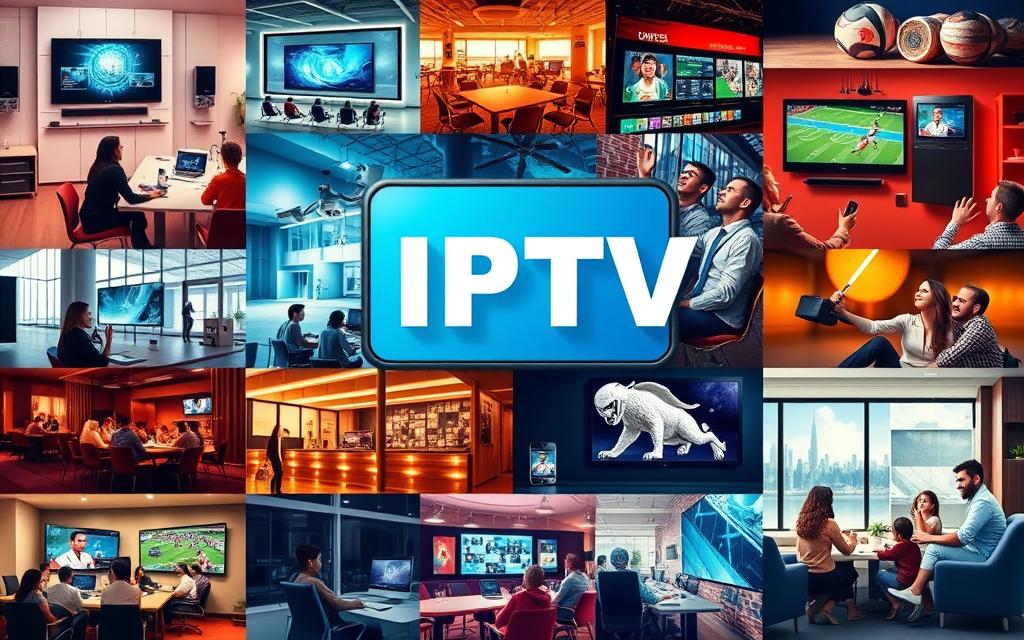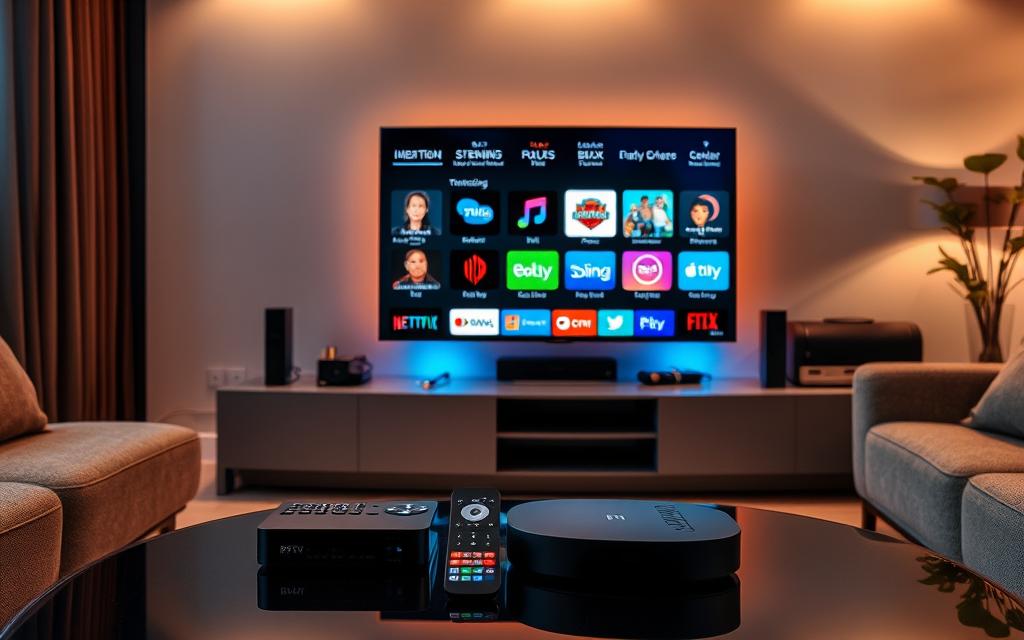“The greatest danger in times of turbulence is not the turbulence; it is to act with yesterday’s logic.” – Peter Drucker. This quote is especially relevant as we dive into the evolving world of IPTV technology. It marks a significant shift in our entertainment habits.
IPTV, or Internet Protocol Television, is changing the game in broadcasting. With a growing demand for on-demand content, many wonder about IPTV. It’s different from regular TV because it uses the internet for streaming, not satellite or cable. This makes IPTV a more adaptable and convenient choice for viewers.
IPTV brings a variety of content right to viewers, from live TV to movies. It encodes this content into IP-ready formats. This approach ensures a top-notch viewing journey with extras like video-on-demand and electronic program guides. We aim to shed light on IPTV’s impact. It’s reshaping how we see entertainment, pushing us towards a digital-first approach.
Key Takeaways
- IPTV utilizes high-speed internet for seamless, on-demand content delivery.
- The technology circumvents traditional cable and satellite limitations, providing users with unprecedented flexibility.
- By moving to a digital-first approach, various industries embrace IPTV for better content delivery.
- IPTV supports interactive features and high-definition content, boosting user engagement.
- The growing need for personalized streaming is changing IPTV’s business scene.
What is IPTV?
In our fast-changing world, knowing what is IPTV matters. It stands for a new way to watch TV, using the Internet Protocol over the internet. This tech lets you easily stream shows and movies on various devices. It brings content right to you through broadband, moving away from old cable or satellite systems.
Definition of IPTV
To grasp iptv explained, see it as different from old TV. It sends video over the internet, offering on-demand shows. You can watch on TVs, phones, or tablets, showing its modern touch. An IPTV box brings this array of programs to your fingertips.
How IPTV Differs from Traditional TV
IPTV and old-style TV don’t work the same. Instead of cable or satellite, IPTV uses internet. This gives you more control over what and when you watch. It’s a big change in enjoying TV. With choices like Video on Demand and live streams, it offers more flexibility. Also, IPTV’s way of sending shows one by one could make watching more personal.
History of IPTV Technology
The journey of IPTV has been full of ups and downs. It has grown into a popular way to deliver media. Learning about IPTV’s history shows its triumphs and early hurdles.
Early Challenges in IPTV Development
The idea of IPTV came up in the early 1990s. Early on, it faced big hurdles like needing lots of bandwidth and poor internet setups.
Key Technological Advancements
By the late 1990s, more people had fast internet, helping IPTV grow. Innovations in video compression, like MPEG-2 and MPEG-4, helped stream high-quality video easily. The start of IPTV in the US was marked by US West’s TeleChoice in 1998, using VDSL to send TV over phone lines.
Global Expansion of IPTV
IPTV started in America but soon spread worldwide. Countries like the UK and Australia quickly adopted it, with Kingston Communications launching its TV service in 1999. By 2015, IPTV had more users than satellite TV in Western Europe. This growth shows IPTV’s increasing popularity, with more providers offering it globally.
How IPTV Works
IPTV is fascinating when you dive into how it works. It uses a network setup with fiber optics for fast and reliable data transfer. This ensures smooth streaming with fewer problems. It’s how service providers give you a great watching experience.
Network Architecture of IPTV
The IPTV system has many parts working together. It uses a content delivery network (CDN) and set-top boxes to show programs. IPTV providers have over 20 years of experience. They offer many channels at prices starting from $19.99.
Content Delivery Methods: Multicast vs Unicast
Multicast and unicast are two ways IPTV sends content. Multicast sends one video to many people at once, perfect for live events. It’s used for shows that lots of viewers watch together.
Unicast sends videos to viewers on request, great for video on demand. It lets people watch what they choose. This makes IPTV versatile, fitting for different places like hotels and offices.
IPTV Services Overview
IPTV services have changed how we get our entertainment, meeting the needs of many. We’ll look into two main points about IPTV: the kinds of services offered and some top IPTV providers.
Types of IPTV Services Available
The types of IPTV services offer something for everyone. Here’s a look at the most common options:
- Live TV: This includes real-time streaming of TV shows, news, and sports.
- Video-on-Demand (VOD): Lets you watch your favorite content whenever you want.
- Time-Shifted TV: Watch shows that aired earlier at a time that works for you.
- Hybrid Services: Mixes regular TV channels with online streaming.
Popular IPTV Service Providers
Some popular IPTV providers stand out by offering great services and a wide range of channels. Noteworthy names include:
| Provider | Channels Offered | Subscription Cost |
|---|---|---|
| 2TV Store | Thousands of channels, including international | Starting at $19.99 |
| IPTV Year | 16,000+ live channels | From €14.99/month |
| IPTV Portal | 22,000+ online channels | Various pricing options available |
IPTV services have led the streaming market for over 20 years, showing they can change and grow. They offer a mix of live TV, catch-up TV, and VOD. With choices like Smart IPTV and Liveplayer IPTV, viewers get a lot of channels in great quality.
Benefits of IPTV
IPTV technology has changed how we enjoy entertainment. It’s great for people who love flexibility, personalization, and saving money. IPTV offers better viewing options and can help you save a lot compared to traditional services.
Flexibility and Personalization
IPTV’s flexibility is a big plus. You can pick your own channels and watch lots of on-demand shows. This means you can watch what you like, adding or dropping channels as you want. IPTV also lets you pause, rewind, or fast-forward shows and movies. You can even switch devices easily, moving from your TV to your smartphone or computer.
Cost-Effectiveness Compared to Cable
Switching to IPTV can save you a lot of money compared to cable TV. IPTV plans are cheaper and give you access to thousands of channels and big on-demand libraries. Plus, there are no long contracts, so you can change your plan anytime without hassle. As people look for good but affordable content, IPTV stands out as a smart choice.
| Feature | IPTV | Cable/Satellite |
|---|---|---|
| Channel Customization | High flexibility with personalized lineup | Static packages with limited options |
| On-Demand Content | Extensive library available | Limited to scheduled programming |
| Cost | Typically lower monthly fees | Higher costs with long-term commitments |
| Viewing Devices | Multi-device accessibility | Primarily TV-based |
| Picture Quality | High definition with superior quality | Varies greatly by provider |
Challenges in IPTV Streaming
IPTV technology is getting better, but some problems still make it hard for users to enjoy it fully. One major issue is that IPTV needs a fast internet connection to work well. If the internet is slow, viewers will see a lot of buffering. This makes watching shows less enjoyable.
Dependence on High-Speed Internet
For a great IPTV experience, you need a strong internet connection. Industry experts say that not having enough speed is a big problem. This is true especially now, as we want to watch shows in high definition or even in 4K and UHD quality. But sometimes, our internet systems can’t handle these formats well.
To watch IPTV without problems, you must have fast internet. This ensures you get to enjoy high-quality streaming without losing picture quality.
Potential Quality Issues
There are several reasons why IPTV might not look so good. Network congestion and limits set by Internet Service Providers (ISPs) can interrupt your viewing. This is especially true when lots of people are online at the same time. Also, running an IPTV system well requires experts who know what they’re doing. This adds more difficulty in making sure everyone can enjoy good quality videos on all devices.

IPTV Features and Functionality
IPTV brings a flexible viewing experience with its advanced features. These not only make watching TV more convenient but also meet your entertainment needs.
Video-on-Demand (VOD) Services
The video on demand services in IPTV let you pick and watch content right away over the internet. This change has made watching shows and movies more enjoyable, with Netflix, Amazon Prime Video, and Disney+ leading the way. You get access to many movies and series anytime without waiting for them to air.
Time-Shifted TV Options
Time-shifted TV, or catch-up TV, lets you watch shows after they’ve aired. You can pause, rewind, or fast-forward live TV, giving you more control. BBC iPlayer and Hulu have done a great job adding this feature for better enjoyment.
Interactive TV Guides
Interactive TV guides greatly improve how you find what to watch.
They make it easy to sort through many programs and find your interests. These guides also give detailed info on shows and when they’re on, so you never miss out.
Understanding IPTV Technology
IPTV technology has changed the way we stream videos today. It makes streaming faster and doesn’t lower the quality. Encoding and compression are key parts of this tech. They help send content smoothly to users all over the world.
Content Encoding and Compression
IPTV works by changing video signals to fit the internet better. It uses formats like H.264 and HEVC. These formats make files smaller but keep the picture clear. Thanks to this, you can enjoy lots of shows and live channels without any delays.
Role of Set-Top Boxes in IPTV
Set-top boxes for IPTV link your internet to your TV. They change IPTV streams into something your TV can show. This means you get to watch smoothly. These boxes are also easy to use. They let you find shows quickly and have special features like recording.
This technology turns regular and on-demand shows into a great experience for viewers. With set-top boxes, watching TV becomes more enjoyable.
Use Cases of IPTV Across Industries
IPTV shows its power in different fields, showing us its key role today. With new tech, IPTV changes how we get and enjoy content. It has become vital in many sectors.
Home Entertainment Applications
At home, IPTV is changing how we watch TV, offering more than old cable systems. Families get on-demand shows on many devices, making everyone happy. IPTV’s growth lets us add channels and features easily while keeping the video clear. This new way brings more value than the old methods.
IPTV in Education and E-Learning
Schools are using IPTV to make learning better. It helps with studying from far away, giving students classes and resources anytime. IPTV makes education wider and adds cool tools like virtual classes and interactive learning.
Business Communications and Training
Companies are turning to IPTV for better work chats and training. They mix digital signs with IPTV to share news, training videos, and messages everywhere, boosting involvement. This connected method makes work smoother. It helps businesses share content well and improve how they talk.

Future of IPTV
The future of TV is digital and personal. IPTV, or Internet TV, is changing to meet viewer needs. This change aims to bring better services and more shows.
IPTV 2.0: The Next Generation
IPTV is getting smarter, thanks to new tech. It’s changing to offer programs that fit what you like. More people, especially the young, are choosing IPTV for its on-demand shows.
With AI and learning machines, it suggests shows you’ll love. This makes watching TV a lot more fun.
Integrating Cloud Technologies
Using cloud tech makes IPTV better and more efficient. It cuts costs and lets us stream shows faster. Now, you can enjoy shows in 4K quality without waiting.
Also, 5G will make streaming smoother and more reliable. Everyone’s looking forward to these upgrades.
| Feature | IPTV 1.0 | IPTV 2.0 |
|---|---|---|
| Content Delivery | Static, traditional | Dynamic, personalized |
| Technology Integration | Limited cloud use | Full cloud capabilities |
| Content Quality | Standard Definition | High Definition & 4K |
| User Interaction | Basic | Advanced (AI-driven) |
| Scalability | Moderate | High |
IPTV’s future looks bright. It’s focusing on giving viewers a great experience while keeping costs low..
Global Reach of IPTV Services
IPTV’s global reach is growing fast, changing how people access and enjoy content. Each region has its own rules and deals, leading to big differences in IPTV services. This means the channels and shows available can vary greatly, making for a shifting scene for viewers all over.
IPTV in Different Regions
In places like North America and Europe, IPTV is big, with deals with giants like Netflix and Amazon Prime Video. This offers a wide array of content to appeal to many. In the Asia-Pacific, IPTV is set to boom, especially in China and India, due to rising demand for flexible viewing. But, geographical limitations in IPTV can limit access to certain content.
Impact of Geographical Limitations
Geographical limits on IPTV affect what users can watch, as laws may block some content in certain areas. Though the global IPTV market was huge, at USD 68.78 billion in 2023, it could hit USD 276.38 billion by 2032. Yet, local rules shape what digital content you can get. The move to internet streaming shows a trend towards more personal, on-demand viewing. But, local laws and limits may block some content.
Conclusion
IPTV is changing how we view media, bringing new ways to watch and save money. Features like Video-On-Demand and time-shifted TV greatly improve our watching habits. This makes it very attractive to those who love technology. Big companies such as FOX, CBS, and NBC have created apps for catch-up TV. This bridges the traditional TV and modern streaming worlds.
There are many good things about IPTV, but there are some hurdles too. One issue is the need for fast internet, which can be a problem in places without it. But, technology is getting better, using things like RTP and HTTP to improve how it works. This results in a better experience for the user.
The future of IPTV looks bright, moving towards IPTV 2.0. This brings advanced features and more content choices. With the number of service providers growing and content getting better, IPTV is transforming our entertainment world. It offers a deeper and more tailored watching experience.
FAQ
What is IPTV?
How does IPTV differ from traditional TV?
What are the benefits of using IPTV services?
What types of IPTV services are available?
What should I consider for a good IPTV experience?
How do content delivery methods like multicast and unicast work in IPTV?
What roles do set-top boxes have in IPTV?
How do I choose a reliable IPTV provider?
What are the potential quality issues with IPTV?
Is IPTV suitable for educational purposes?
Source Links
- IPTV Explained: What It Is and How It Works
- What is IPTV? How IPTV works? Best IPTV Devices, Services, and more!
- What is IPTV? Understanding the Ongoing Revolution in Digital Media
- What is IPTV (Internet Protocol television) and how does it work?
- What is IPTV? A Deep Dive into its History, Technology, and Future – Amira Labs
- Internet Protocol television
- What is IPTV and How Does it Work?
- What is IPTV ? Uniguest IPTV & Digital Signage – Internet Protocol Television
- 15 Best IPTV Service Providers Subscriptions (Top Picks)
- Exploring the Benefits of IPTV for TV: A Comprehensive Overview
- 5 Advantages for IPTV Consumers. Key Benefits of IPTV Platform
- IPTV solutions: The future of broadcast video
- 5 Challenges Going From Traditional DVB To IPTV/OTT Operations
- IPTV Challenges and Solutions in Metro Networks
- What is IPTV, how does it work, and what are the pros and cons?
- What is IPTV? IPTV Service Guide – CLS Learn
- IPTV Meets Digital Signage: Benefits, Uses & Applications
- IPTV vs. OTT – Internet TV Explained
- What is Internet Protocol Television (IPTV)? – Nevron
- Why is IPTV the Future of Television?
- Microsoft Word – IPTVrapport.doc
- IPTV Market Size, Share, Growth, Forecast | Global Report 2032
- What is the Difference Between IPTV and OTT?
- IPTV In a Nutshell
- What is IPTV (Internet Protocol Television) & How Does It Work?



